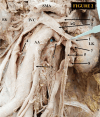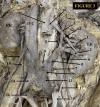Protean Drainage Patterns of the Left Renal Vein: A Cadaveric and Retrospective Clinical Study on the Surgical Implications and Technical Feasibility
- PMID: 39050300
- PMCID: PMC11268398
- DOI: 10.7759/cureus.63037
Protean Drainage Patterns of the Left Renal Vein: A Cadaveric and Retrospective Clinical Study on the Surgical Implications and Technical Feasibility
Abstract
Background: The diverse drainage patterns of the left renal vein (LRV), often with asymptomatic congenital anomalies, present considerable challenges in renal and retroperitoneal surgical contexts. The potential for significant bleeding and subsequent renal compromise upon vascular injury highlights the need for increased surgical awareness.
Objective: This study investigates the LRV's variable anatomical drainage patterns and morphometry. It also evaluates the embryological factors contributing to these variations and discusses their surgical implications and technical considerations.
Methods: Anatomical dissections were conducted on 21 adult human cadavers within the Department of Anatomy. Concurrently, a retrospective analysis was conducted on 15 patients who underwent various retroperitoneal surgical interventions in the Urology Department. Demographic variables and intraoperative findings were recorded and analyzed.
Results: Dissection analysis predominantly identified preaortic LRVs in 18 cadavers. Notable anatomical variations included a circumaortic left renal vein (CLRV), a delayed preaortic confluence of extrahilar duo LRVs, and an extrahilar tetramerous confluence with a retroiliac topography. The majority of LRVs usually end in the inferior vena cava. However, an extrahilar tetramerous variant had an unusual drainage pathway. Out of 15 cases, three (20%) had a retroaortic left renal vein (RLRV). One patient with a nonfunctioning kidney had type 1 RLRV, and another patient with pelvic ureteric junction obstruction had type 4 retroiliac left renal vein (RILRV). In both of these patients, symptoms were relieved after surgery. In a young patient with left varicocele and microscopic hematuria who had type 2 RLRV, symptoms resolved spontaneously after a few months.
Conclusion: A thorough understanding of the variable anatomical drainage patterns of the LRV is crucial for surgeons. Accurate preoperative identification can provide valuable insights, potentially leading to improved surgical outcomes in renal procedures.
Keywords: circumaortic; delayed confluence of veins; donor nephrectomy; inferior vena cava; left common iliac vein; left renal vein; renal transplant; retroaortic; variable anatomical drainage pattern.
Copyright © 2024, Shreevastava et al.
Conflict of interest statement
Human subjects: All authors have confirmed that this study did not involve human participants or tissue. Animal subjects: All authors have confirmed that this study did not involve animal subjects or tissue. Conflicts of interest: In compliance with the ICMJE uniform disclosure form, all authors declare the following: Payment/services info: All authors have declared that no financial support was received from any organization for the submitted work. Financial relationships: All authors have declared that they have no financial relationships at present or within the previous three years with any organizations that might have an interest in the submitted work. Other relationships: All authors have declared that there are no other relationships or activities that could appear to have influenced the submitted work.
Figures









References
-
- Schoenwolf G, Bleyl S, Brauer P, et al. Philadelphia: Elsevier Health Sciences; 2021. Larsen’s human embryology.
-
- Sadler TW. Lippincott Williams & Wilkins; 2022. Langman's medical embryology.
-
- Left renal vein variations. Satyapal KS, Kalideen JM, Haffejee AA, Singh B, Robbs JV. Surg Radiol Anat. 1999;21:77–81. - PubMed
-
- Evaluation of the frequency of left renal vein variations in computed tomography and its relationship with cancer development. Kuzan TY, Kuzan BN, Telli TA, Tüney D. Folia Morphol (Warsz) 2020;79:793–798. - PubMed
LinkOut - more resources
Full Text Sources
